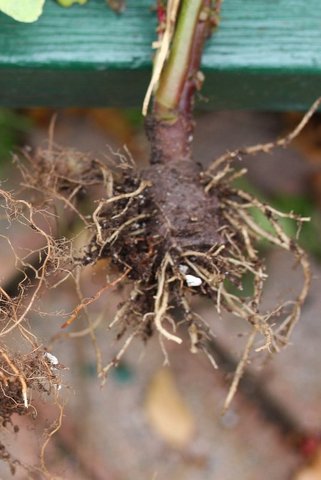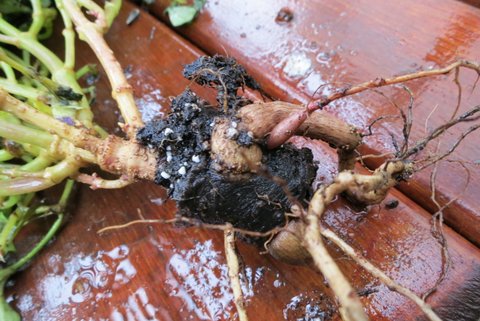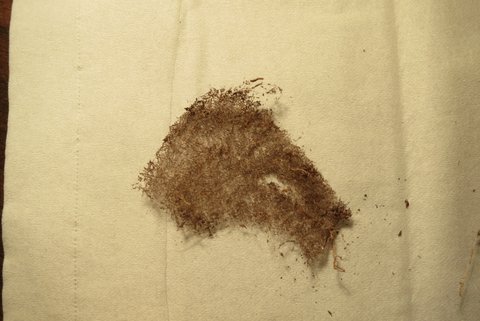

There was considerable interest in my post last week, where I shared a photo from Canadian garden writer David Hobson. I wasn’t impressed with the production method and materials for the petunia that was illustrated, but readers wanted to know a little more about the plant (how did the top of it look?) and the mesh encasing the root ball. So I contacted David, and he graciously shared some more information and photos with me.
Here are David’s comments:
“Attached are three photos. Not the best, but the one beside the broom is the original that I sent you. It’s been lying on the patio and has lost a few stems. I don’t have a shot of it in flower as I didn’t particularly like it — one of those new wine and yellow striped things. It was in a container with a couple of other plants and did flower somewhat, but not noticeably well.

“Next shot appears to be a coleus — slightly more roots, but hardly a star.

“Sadly, I can’t tell what number three is for sure as I retrieved it from the compost heap, but it has had an awful time trying to burst free with its tuberous roots.

“I do plant as many as 100 containers in all shapes and sizes each spring and all are all well tended, planted in my own compost mix, supplemented with water soluble fertilizer, watered as required, and suitably oriented.”Certainly, how well these plants thrive and produce blooms is an issue, but given the restrictive nature of this material, it does not appear to be at all biodegradable, a quality that one would think essential. After almost six months in soil, it has barely changed its structure.
“As an after note, I removed the fabric from the petunia and dried it. It is a very fine mesh. I then subjected it to a heat source whereupon and it shriveled and melted as one would expect a plastic material to perform — draw your own conclusions.”

The first photo is the petunia from last week’s post. I think it’s fair to say that the root system is significantly impaired and would require frequent watering to support the above-ground portion (which is pretty wimpy looking). The other photos show the same problems. And it’s apparent from David’s description that the plug wrap is probably made of a plastic of some sort.So, yes, I think it’s the production method – specifically the plastic mesh – that’s creating these poor quality root systems. Gardeners will have better luck with seedling liners filled with loose media.






The most dramatic evidence I’ve seen of the problem with netting on peat pellets was in a discussion on gardenweb.com a few years ago. Great pictures of what can happen if the netting is not torn away so the roots can expand. I don’t know if the pellets are made in the same way now, but it’s a lesson worth sharing. You can see for yourself here:
http://forums2.gardenweb.com/forums/load/cornucop/msg0314220213059.html?23
I hate those Jiffy peat pellet things, but even when I used them one year I took one look at that mesh and didn’t think it had a chance of biodegrading this decade so I removed it.
I’m not too keen on the peat pots either; they just don’t seem to degrade fast enough. When I get one, I tear the outer pot off and compost it.
By far my best seedlings come out of either large pots, where they can stay undisturbed until transplant time, or from some wooden seed flats that I have. Both retain moisture well and the soil temp doesn’t seem to swing as fast. And both methods are far easier than messing with those little pellets. A horticultural setup where plants can be constantly monitored and misted probably doesn’t need as much help, but for a home gardener, soil volume really makes a difference.
Just a note, the plants illustrated were grown and marketed in 2 1/2″ pots, not grown in jiffy pots. Although I referred to the material as a mesh, it is more like a fabric, and even now is surprisingly tough.
Thank you, thank you for this updated post. This is much closer to the info I’ve come to rely on from you guys. Thank you too for revealing the challenges with this particular system. Superficially, this plug looks VERY similar to an Elle plug, but with a plastic based plug wrap instead of paper. We’ve never had any troubles with Elle plugs (I grow thousands of annuals each year from Elles) and the difference in may be wrap material. I will definitely be on the lookout for the plastic version and will send this post to my plug vendors to make them aware of the challenges in case they were considering changing. Thank you again for the follow up on this!